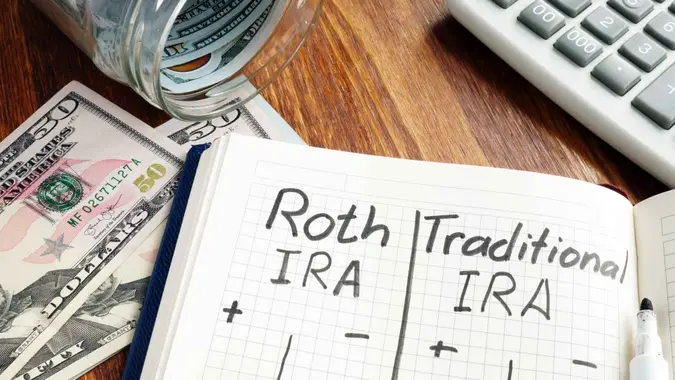Can You Borrow From a Roth IRA?

Commitment to Our Readers
GOBankingRates' editorial team is committed to bringing you unbiased reviews and information. We use data-driven methodologies to evaluate financial products and services - our reviews and ratings are not influenced by advertisers. You can read more about our editorial guidelines and our products and services review methodology.

20 Years
Helping You Live Richer

Reviewed
by Experts

Trusted by
Millions of Readers
Some types of retirement accounts allow you to borrow against them with formal loans, such as a 401(k) loan. That’s not an option with Roth IRAs, which do not have formal loan programs.
However, there are limited methods that you can use to access funds if needed. It’s important to understand the rules about how these methods work, however, so you can best avoid penalties, protect your retirement savings, and preserve tax advantages.
Why You Can’t Treat a Roth IRA Like a Loan
IRS rules prohibit loans from IRAs, which includes Roth IRAs. Loans are only possible from qualified plans that satisfy the requirements of a 401(a), from governmental plans, and from certain annuity plans.
If you want to pull money from your Roth IRA, however, you can access funds with withdrawals.
Withdrawals are different from loans. Depending on the timing of the withdrawal, you may face some penalties or lose tax advantages. And unlike 401(k) loans, which allow you to borrow from your retirement savings but then pay it back with interest, you aren’t required to pay the balance back.
What You’re Allowed to Withdraw from a Roth IRA
One of the biggest advantages of a Roth IRA is flexibility — you can withdraw your original contributions at any time, tax- and penalty-free. That’s because you already paid taxes on this money before putting it into the account.
For example, if you’ve contributed $15,000 to your Roth IRA over the years, you can take out up to $15,000 whenever you want — regardless of your age or how long the account has been open — without owing taxes or penalties.
The key distinction is that this only applies to contributions. If you withdraw earnings (the growth on your investments), those withdrawals may be subject to taxes and penalties unless you meet certain conditions, such as being at least 59½ and having held the account for five years, or qualifying for an exception.
Using the 60-Day Rollover as a Short-Term Loan
While not a true loan, there’s a strategy some people use as a short-term cash solution called the “60-day rollover rule.” You can withdraw funds from your Roth IRA and then redeposit the same amount within 60 days in another account without penalties or taxes, as long as you meet certain conditions.
Here’s how it works:
- You withdraw money from your Roth IRA
- You have exactly 60 days to put the money back into an IRA
- This can only be done once per 12-month period across all your IRAs
- If you miss the 60-day deadline, the withdrawal becomes permanent and subject to taxes and penalties
This strategy is risky and should only be considered if you’re absolutely certain you can replace the funds within 60 days.
Taxes and Penalties on Early Roth IRA Earnings Withdrawals
While you can always withdraw contributions penalty-free, the same isn’t true for earnings, which is the growth on your investments.
If you withdraw earnings before age 59½ or before meeting the 5-year rule, you’ll owe:
- Regular income tax on the withdrawal
- An additional 10% early withdrawal penalty
The 5-year rule states that you must have had your Roth IRA open for at least five years before you can withdraw earnings tax-free, even after age 59½.
Exceptions to the Early Withdrawal Penalty
The IRS provides several qualified exceptions that allow you to withdraw earnings without the 10% penalty (though you may still owe income taxes on earnings):
Education and Family Expenses:
- Higher education expenses for you, your spouse, children, or grandchildren
- Birth or adoption expenses (up to $5,000 per child)
Housing and Medical:
- First-time home purchase (up to $10,000 lifetime maximum)
- Unreimbursed medical expenses exceeding 7.5% of your adjusted gross income
- Health insurance premiums if you’re unemployed
Other Qualifying Situations:
- Permanent disability
- Death of the account holder (for beneficiaries)
- IRS levy on the account
- Qualified disaster distributions
- Surviving domestic abuse
Even with these exceptions, remember that withdrawing earnings before age 59½ and the 5-year mark may still result in income taxes on the withdrawn amount.
The Pitfalls of Treating a Roth IRA Like a Loan
Using your Roth IRA as a source of cash comes with significant downsides:
- Risk of permanent savings loss. If you use the 60-day rollover strategy and can’t repay within the deadline, you’ll face taxes and penalties. More importantly, you’ll permanently lose those funds from your retirement savings since there are contribution limits.
- Contribution limits. If you withdraw money permanently, you can’t simply put it back later due to annual contribution limits. For 2025, the contribution limit is $7,000 (or $8,000 if you’re 50 or older). There are also income limits that determine how much you can contribute to your Roth IRA.
- Missed growth opportunity. Money withdrawn from your Roth IRA can’t grow tax-free anymore. Given the power of compound growth over decades, even a temporary withdrawal can cost you significantly in retirement.
- Limited flexibility. You can only do one rollover per year, which restricts your ability to use this strategy repeatedly.
Alternative Options to Access Cash
Before tapping your Roth IRA, consider these alternatives:
- 401(k) loan. If your employer’s 401(k) plan allows it, you can typically borrow up to 50% of your vested balance or $50,000, whichever is less. You’ll pay interest, but it’s paid back to your own account.
- Home equity or lines of credit: A home equity loan or line of credit often offers lower interest rates than personal loans and may provide tax-deductible interest.
- Personal loans: While interest rates are higher, personal loans don’t put your retirement savings at risk.
Each option has pros and cons, but they all allow you to keep your retirement savings intact and growing.
Times You Could Lean on Your Retirement Funds (and Why)
While we typically recommend waiting to access your retirement funds until you can do so without paying additional taxes or penalties, here are some situations where accessing Roth IRA funds might make sense:
- Emergency medical expenses. You’re 45 and face a $20,000 medical bill not covered by insurance. You could withdraw contributions penalty-free, or if you need to touch earnings, the medical expense exception might apply.
- First-time home purchase. You’re 35 and need an extra $10,000 for a down payment. You can withdraw this amount from earnings penalty-free (though income taxes may apply) under the first-time homebuyer exception.
- Short-term cash flow. You need $5,000 for 30 days due to a delayed paycheck to cover rent. The 60-day rollover might work if you’re absolutely certain you can repay it quickly. However, this is risky and should be a last resort.
Before You Tap Your Roth IRA, Know the Risks
Direct loans aren’t allowed from Roth IRAs. While your contributions are accessible, there are strict rules about taxes and potential penalties on withdrawing earnings.
It’s also important to keep in mind that withdrawing funds from your Roth IRA isn’t the same as withdrawing from a savings account. In addition to the potential penalties, remember that there are limits on how much you can contribute each year. Those contributions could also miss out on significant growth, which could set back your savings come retirement time.
If you’re unsure of whether withdrawing from your Roth IRA is the right choice, you can talk to a financial advisor. They can help you determine if there are better options available.
 Written by
Written by  Edited by
Edited by 

























